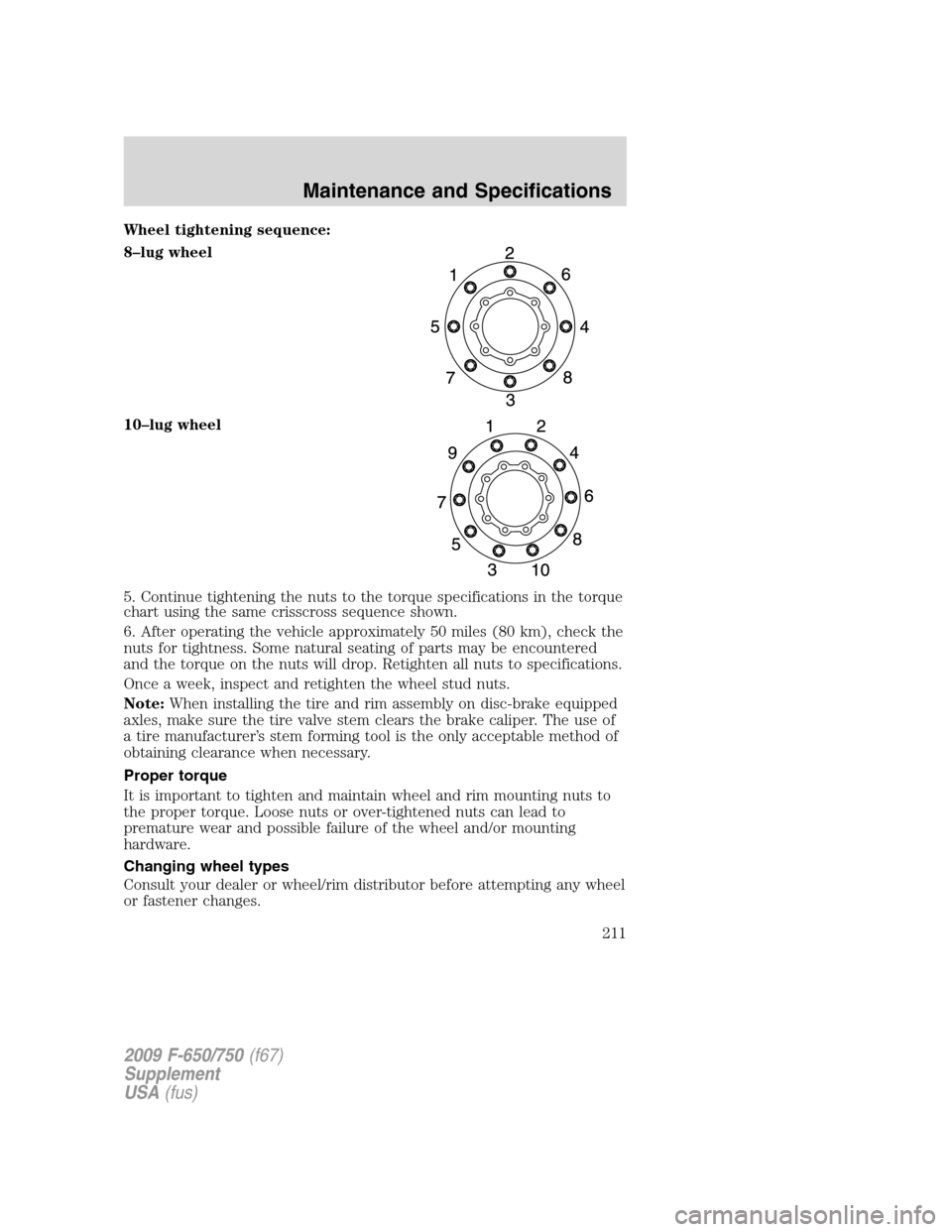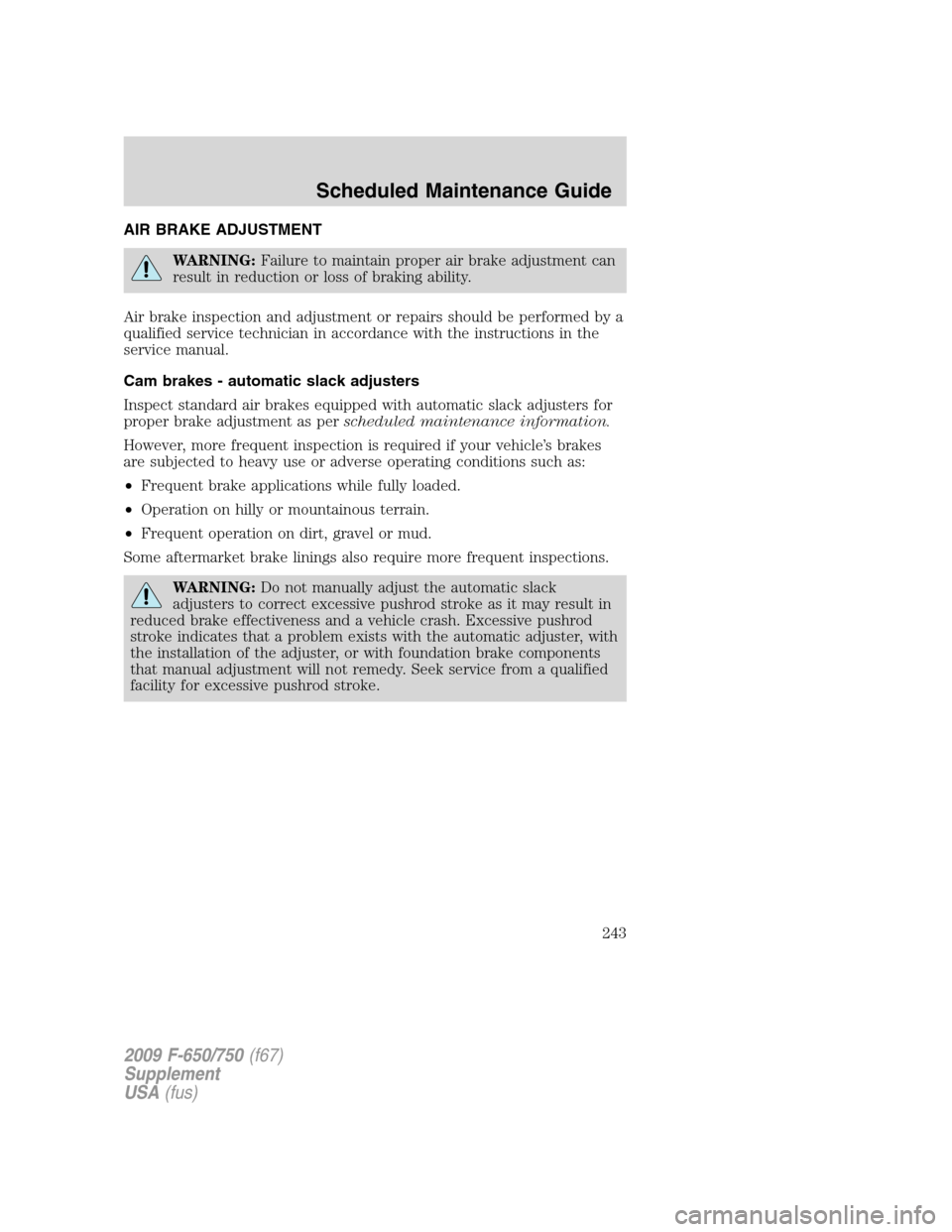Page 211 of 276

Wheel tightening sequence:
8–lug wheel
10–lug wheel
5. Continue tightening the nuts to the torque specifications in the torque
chart using the same crisscross sequence shown.
6. After operating the vehicle approximately 50 miles (80 km), check the
nuts for tightness. Some natural seating of parts may be encountered
and the torque on the nuts will drop. Retighten all nuts to specifications.
Once a week, inspect and retighten the wheel stud nuts.
Note:When installing the tire and rim assembly on disc-brake equipped
axles, make sure the tire valve stem clears the brake caliper. The use of
a tire manufacturer’s stem forming tool is the only acceptable method of
obtaining clearance when necessary.
Proper torque
It is important to tighten and maintain wheel and rim mounting nuts to
the proper torque. Loose nuts or over-tightened nuts can lead to
premature wear and possible failure of the wheel and/or mounting
hardware.
Changing wheel types
Consult your dealer or wheel/rim distributor before attempting any wheel
or fastener changes.
2009 F-650/750(f67)
Supplement
USA(fus)
Maintenance and Specifications
211
Page 223 of 276
ComponentLubrication
typeViscosity /
Ambient
temperature /
NotesEquivalent
Ford part
name /
number
Driveshaft
U-joint GC/LB NLGI #2
lithium
complex-based
moly grease or
multi-purpose
lithium
complex grease— Motorcraft
Premium Long
Life Grease /
XG-1-C
Clutch
Release bearing /
shafts / forkGC/LB NLGI #2
lithium
complex-based
moly grease or
multi-purpose
lithium
complex grease— Motorcraft
Premium Long
Life Grease /
XG-1-C
Reservoir DOT 3,
ESA-M6C25–A
or
WSS-M6C62–A— Motorcraft High
Performance
DOT 3 Motor
Vehicle Brake
Fluid, PM-1 or
PM-1–C
2009 F-650/750(f67)
Supplement
USA(fus)
Maintenance and Specifications
223
Page 232 of 276
ComponentLubrication
typeViscosity /
Ambient
temperature /
NotesEquivalent
Ford part
name /
number
Door window
regulatorsNGLI #2
multipurpose
lithium
complex grease— Motorcraft
Multi-Purpose
Grease Spray /
XL-5 or
Motorcraft
Multi-Purpose
Grease / XG-4
Weatherstripping Silicone
lubricant— Motorcraft
Silicone Spray /
XL-6
Engine oil
Refer to engine operator manual
Brake fluid
Master cylinder DOT 3,
WSS-M6C62-A
or
WSS-M6C65-A1— High
Performance
DOT 3 Motor
Vehicle Brake
Fluid, PM-1-C
(U.S.) or
CPM-1-C
(Canada)
REFILL CAPACITIES
Rear axle
Axle codeWeight
capacity - lb.
(kg)DescriptionFluid capacity
- pints
(liters)1,2
S135–S 13500 (6123) Single rear axle,
single reduction24.5 (11.6)
4S150–S 15500 (7031) Single rear axle,
single reduction24.5 (11.6)
17060S 17500 (7938) Single rear axle,
single reduction28.0 (13.2)
2009 F-650/750(f67)
Supplement
USA(fus)
Maintenance and Specifications
232
Page 239 of 276

FACTORY AUTHORIZED SYSTEMS CHECKS
In the event that your vehicle experiences a component related concern,
please contact your Ford dealership. The Ford Motor Company Trained
Technicians who work at Ford dealerships are specifically trained to
understand your vehicle.
A proper repair begins with a thorough system check. A Factory
Authorized Systems Check can ONLY be found at a Ford dealership. In
some circumstances, the technician may need to request your
authorization to perform additional operations to determine the final
diagnosis. The technician’s goal is to ensure that your vehicle is fixed
right the first time, at the best value to you.
The following list represents several of the Factory Authorized Systems
Checks available at a participating Ford dealers:
•Air Conditioning
•Check Engine Light
•All Wheel Drive and 4x4
•Automatic Transmission
•Engine Cooling and Cabin Heating
•Steering and Suspension
•Charge/Start/Battery
•Wheel Alignment
•Anti-Lock Brake System
EMISSIONS CONTROL SYSTEM
To ensure the emissions control systems operate effectively, you should
have the services listed in the maintenance schedule performed at the
specified time and mileage/km intervals. You should avoid running out of
fuel or turning off the ignition while the vehicle is in motion, especially
at high speeds.
WARNING:Because of high engine compartment and exhaust
system temperatures resulting from emissions equipment, do not
park, idle or operate your vehicle in dry grass or other dry ground
cover where the possibility of ground fire exists.
Do not make unauthorized modifications to the engine or vehicle.
Modifications causing increased amounts of unburned fuel to reach the
exhaust system can significantly increase the temperature of the engine
compartment and/or the exhaust system.
2009 F-650/750(f67)
Supplement
USA(fus)
Scheduled Maintenance Guide
239
Page 243 of 276

AIR BRAKE ADJUSTMENT
WARNING:Failure to maintain proper air brake adjustment can
result in reduction or loss of braking ability.
Air brake inspection and adjustment or repairs should be performed by a
qualified service technician in accordance with the instructions in the
service manual.
Cam brakes - automatic slack adjusters
Inspect standard air brakes equipped with automatic slack adjusters for
proper brake adjustment as perscheduled maintenance information.
However, more frequent inspection is required if your vehicle’s brakes
are subjected to heavy use or adverse operating conditions such as:
•Frequent brake applications while fully loaded.
•Operation on hilly or mountainous terrain.
•Frequent operation on dirt, gravel or mud.
Some aftermarket brake linings also require more frequent inspections.
WARNING:Do not manually adjust the automatic slack
adjusters to correct excessive pushrod stroke as it may result in
reduced brake effectiveness and a vehicle crash. Excessive pushrod
stroke indicates that a problem exists with the automatic adjuster, with
the installation of the adjuster, or with foundation brake components
that manual adjustment will not remedy. Seek service from a qualified
facility for excessive pushrod stroke.
2009 F-650/750(f67)
Supplement
USA(fus)
Scheduled Maintenance Guide
243
Page 245 of 276
Daily owner checks
EngineCheck the air filter restriction gauge.
Check the engine oil.
Inspect the coolant level
Brake systemCheck the air brake system reservoir
automatic drain valve operation.
Drain the air brake system reservoir -
manual valve.
Transmission systemVisually check the automatic
transmission for fluid leakage.
Steering systemCheck the power steering pump fluid
level and check the system for leaks.
Check the entire vehicle for evidence
of fluid leaks.
U.S. Department of
Transportation, Federal
Highway Administration
requirements (ensure that
the entire system is
functioning properly)Check the service brakes.
Check the parking brake.
Check the steering mechanism.
Check the lighting devices and
reflectors.
Check the tires.
Check the horn.
Check the windshield wipers.
Check the rear vision mirrors.
Check the wheels and rims.
Check the emergency equipment.
2009 F-650/750(f67)
Supplement
USA(fus)
Scheduled Maintenance Guide
245
Page 246 of 276

Check every oil change
Engine systemCheck the engine cooling system -
hoses, clamps and protection*.
Inspect the drive belts.
Exhaust systemInspect the entire exhaust system
(including the inlet pipe(s),
muffler(s), outlet pipe(s), clamps and
fasteners) for holes, leakage,
breakage, corrosive damage and
separation from other components.
Adjust, service or replace with the
same or the equivalent part. (Also a
noise emission control service).
Suspension systemTighten the front and rear spring
U-bolts to the specified torque.
Driveline and rear axle
systemLubricate the U-joints and the slip
yoke.
Brake systemLube the air brake foot control valve,
hinge and roller.
Inspect the drum brake linings
through the inspection holes.
Lubricate the brake camshafts (air
brakes only).
Lubricate the brake slack adjuster (air
brakes only).
Lubricate rear caliper slide rails.
Inspect the disc brake pads and the
piston boots (hydraulic brakes only).
Clutch systemLubricate the clutch release cross
shaft and all linkages.
Check the clutch fluid.
Fuel systemDrain the accumulated water or
sediment from the fuel tank(s).
2009 F-650/750(f67)
Supplement
USA(fus)
Scheduled Maintenance Guide
246
Page 247 of 276

Check every oil change
Steering systemLubricate the steering shaft(s),
U-joints and splines when equipped
with grease fittings.
Lubricate the front axle spindle pins.
Lubricate the steering linkage when
equipped with grease fittings.
Grease the power steering gear output
shaft.
* Coolant protection checks should be made just prior to the onset of
freezing weather, where applicable. If coolant is dirty or rusty in
appearance, the system should be drained, flushed and refilled with the
prescribed solution of cooling system fluid and water. Use only
permanent type coolant that meets specifications as listed in your
engine operator’s manual. See the engine manufacturer’s operating
guide for supplemental corrosion inhibitor specifications.
In addition to the items to be performed daily or at each oil change, the
following need to be completed as specified:
GENERAL MAINTENANCE SERVICES
The following are vehicle checks that should be made periodically either
by the owner or a qualified technician. It is recommended that
deficiencies be brought to the attention of your dealer or another
qualified service outlet as soon as possible in order that advice regarding
the need for service or replacement can be obtained.
Maintenance Operation Frequency - Observation
Inspect the automatic slack
adjuster functionInsufficient power shown in loaded
practice stop.
Check the operation of the
brakes, the clutch, and the
steering
(1),(2)
Vehicle handling qualities not up to
par.
Inspect the vehicle for missing,
damaged, or mislocated noise
shieldsExcessive noise emanates from under
the cab or engine compartment.
2009 F-650/750(f67)
Supplement
USA(fus)
Scheduled Maintenance Guide
247